27 oct 2016
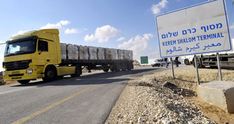
The Israeli occupation authority (IOA) on Thursday morning decided to reduce the number of cargo trucks allowed to enter the besieged Gaza Strip through the Karam Abu Salem crossing to 340 vehicles per day.
In press remarks to the Palestinian Information Center (PIC), Ra’ed Abul-Fotouh, head of the civil authority that coordinates the entry of goods to Gaza, said the Israeli authorities informed the Palestinian side of its intention to decrease the number of trucks crossing into Gaza every day, without providing an explanation for its decision.
350 cargo trucks used to enter Gaza through the crossing almost every day, but now 250 trucks carrying different goods and 90 others laden with cement shipments will be allowed in, according to Abul-Fotouh.
The Karam Abu Salem crossing is the only portal for the access of vital goods and supplies to the Gaza. It is closed every Friday and Saturday as well as during Jewish holidays and festivals.
For his part, the Popular Committee against the Siege warned of the Israeli decision to decrease the cargo trucks entering Gaza, describing it as “a serious development and a measure that would worsen the already tight blockade.”
In press remarks to the Palestinian Information Center (PIC), Ra’ed Abul-Fotouh, head of the civil authority that coordinates the entry of goods to Gaza, said the Israeli authorities informed the Palestinian side of its intention to decrease the number of trucks crossing into Gaza every day, without providing an explanation for its decision.
350 cargo trucks used to enter Gaza through the crossing almost every day, but now 250 trucks carrying different goods and 90 others laden with cement shipments will be allowed in, according to Abul-Fotouh.
The Karam Abu Salem crossing is the only portal for the access of vital goods and supplies to the Gaza. It is closed every Friday and Saturday as well as during Jewish holidays and festivals.
For his part, the Popular Committee against the Siege warned of the Israeli decision to decrease the cargo trucks entering Gaza, describing it as “a serious development and a measure that would worsen the already tight blockade.”
26 oct 2016

Dozens of Palestinian engineers, technicians and workers have been busy building the first seawater desalination project in Gaza, which would partially solve the deteriorating water crisis in the Gaza Strip.
The plant is about 500 meters away from the coast of Deir al-Balah, in central Gaza Strip, and spans over a total area of five acres. There are plans to make it the main water desalination plant in Gaza on an area of 80 acres.
Facing degradation of water resources
Zidan abu Zuhri, a supervisor on the project, said that the importance of this project arose as specialized studies showed that water resources in the Gaza Strip have dramatically degraded. It has become a must to look for alternative water resources to at least to keep Gaza a livable place, he added.
The United Nations has concluded in a recent report that %97 of the Gaza Strip water is unfit for drinking or domestic use.
The project provides water for almost 75,000 people in the south of Gaza in three phases.
According to Abu Zuhri, the first phase is to remove impurities and suspended solids using layers of fine sand, rough gravel and carbon through which water seeps and gets purified. Then water is pumped into another device to remove smaller impurities and suspended solids.
In the third phase, the desalinated water is provided for the people through an 18-kilometer-long pipe.
The estimated annual consumption rate of drinking and agricultural water wells in the Gaza Strip is about 200 million cubic meters (cmc). And it is estimated to reach 260 (cmc) by the year 2020.
Stages of development
The supervisors of the plant said it would be developed through three stages. The first stage, which is the current stage, produces 6000 cubic meters of purified water a day. The second stage would reach 14,000 cubic meters; and funding has been ensured for the second stage. The third stage would produce 20,000 cubic meters a day.
Abu Zuhri said, “Desalinated water is being mixed with municipal water wells to reach the international water quality standards.”
“The main obstacle that delayed the start of the project is importing the needed machinery. The Israeli occupation viewed most of the machinery as dual-use and took time to allow them into Gaza,” he added.
One month to go
Rebhy el-Sheikh, the Palestinian Water Authority's deputy chairman, stated that the first phase of the project cost 10 million euros to produce 6,000 cubic meters of desalinated water a day for 75,000 Palestinians in Rafah and Khan Younis cities.
He confirmed that the project is going to start pumping water within a month, describing it as “the largest vital and strategic project in the Gaza Strip.”
The plant is about 500 meters away from the coast of Deir al-Balah, in central Gaza Strip, and spans over a total area of five acres. There are plans to make it the main water desalination plant in Gaza on an area of 80 acres.
Facing degradation of water resources
Zidan abu Zuhri, a supervisor on the project, said that the importance of this project arose as specialized studies showed that water resources in the Gaza Strip have dramatically degraded. It has become a must to look for alternative water resources to at least to keep Gaza a livable place, he added.
The United Nations has concluded in a recent report that %97 of the Gaza Strip water is unfit for drinking or domestic use.
The project provides water for almost 75,000 people in the south of Gaza in three phases.
According to Abu Zuhri, the first phase is to remove impurities and suspended solids using layers of fine sand, rough gravel and carbon through which water seeps and gets purified. Then water is pumped into another device to remove smaller impurities and suspended solids.
In the third phase, the desalinated water is provided for the people through an 18-kilometer-long pipe.
The estimated annual consumption rate of drinking and agricultural water wells in the Gaza Strip is about 200 million cubic meters (cmc). And it is estimated to reach 260 (cmc) by the year 2020.
Stages of development
The supervisors of the plant said it would be developed through three stages. The first stage, which is the current stage, produces 6000 cubic meters of purified water a day. The second stage would reach 14,000 cubic meters; and funding has been ensured for the second stage. The third stage would produce 20,000 cubic meters a day.
Abu Zuhri said, “Desalinated water is being mixed with municipal water wells to reach the international water quality standards.”
“The main obstacle that delayed the start of the project is importing the needed machinery. The Israeli occupation viewed most of the machinery as dual-use and took time to allow them into Gaza,” he added.
One month to go
Rebhy el-Sheikh, the Palestinian Water Authority's deputy chairman, stated that the first phase of the project cost 10 million euros to produce 6,000 cubic meters of desalinated water a day for 75,000 Palestinians in Rafah and Khan Younis cities.
He confirmed that the project is going to start pumping water within a month, describing it as “the largest vital and strategic project in the Gaza Strip.”
22 oct 2016
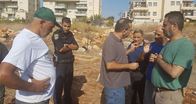
The Israeli occupation police on Friday prevented Palestinian volunteers from carrying out restoration work at the cemetery of Ramiya village in the Galilee.
Local sources reported that a team of volunteers were embarking on renewing the graves when policemen showed up and ordered them to stop and leave.
They added that the police force arrested one of the participants in the voluntary work.
Ramiya was home to a population of 1000, with its territory stretching 98 acres, but today, about 150 persons remain on land stretching only 10 acres.
The rest was appropriated during the biggest Israeli land grab in 1976. Even the area on which 45 families remain to this day is classified as Jewish National Fund property.
The village is not recognized and still without connection to any electricity or water grids.
Local sources reported that a team of volunteers were embarking on renewing the graves when policemen showed up and ordered them to stop and leave.
They added that the police force arrested one of the participants in the voluntary work.
Ramiya was home to a population of 1000, with its territory stretching 98 acres, but today, about 150 persons remain on land stretching only 10 acres.
The rest was appropriated during the biggest Israeli land grab in 1976. Even the area on which 45 families remain to this day is classified as Jewish National Fund property.
The village is not recognized and still without connection to any electricity or water grids.
4 oct 2016
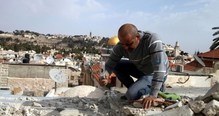
The Israeli occupation authority (IOA) on Monday forced a Palestinian citizen to demolish part of his own house in the Old City of Jerusalem at the pretext of unlicensed construction.
43-year-old Samer Dekaidek said that the Israeli municipal authorities had ordered him two months ago to remove the new section of his house, adding that he decided to carry out the demolition with his own hands after the deadline given to him expired.
Dekaidek was living with his wife, two sons and one daughter in a one-room house, including a kitchen and bathroom, before he decided to build two more rooms and another bathroom for the kids, which he had to dismantle in order to avoid paying more than 60,000 shekels in penalties if Israeli bulldozers had razed it.
“My sons are not living with me now in the house. There is no place for them. They are living in a dormitory…Regardless of what happens, we will remain steadfast in Jerusalem city.
We may destroy today, but we are going to build tomorrow, and we are not leaving the city,” the homeowner said. Last month, five Palestinian citizens in Jerusalem had to raze their own residential and commercial structures after they received similar demolition orders.
For the impoverished Palestinians in Jerusalem, Israeli construction permits are very expensive and often impossible to obtain; therefore, many of them build homes without permits, only to later face Israeli demolition orders and costly fines.
Unable to afford the penalties, a growing number of Palestinians have faced the difficult choice of demolishing their own homes and property.
43-year-old Samer Dekaidek said that the Israeli municipal authorities had ordered him two months ago to remove the new section of his house, adding that he decided to carry out the demolition with his own hands after the deadline given to him expired.
Dekaidek was living with his wife, two sons and one daughter in a one-room house, including a kitchen and bathroom, before he decided to build two more rooms and another bathroom for the kids, which he had to dismantle in order to avoid paying more than 60,000 shekels in penalties if Israeli bulldozers had razed it.
“My sons are not living with me now in the house. There is no place for them. They are living in a dormitory…Regardless of what happens, we will remain steadfast in Jerusalem city.
We may destroy today, but we are going to build tomorrow, and we are not leaving the city,” the homeowner said. Last month, five Palestinian citizens in Jerusalem had to raze their own residential and commercial structures after they received similar demolition orders.
For the impoverished Palestinians in Jerusalem, Israeli construction permits are very expensive and often impossible to obtain; therefore, many of them build homes without permits, only to later face Israeli demolition orders and costly fines.
Unable to afford the penalties, a growing number of Palestinians have faced the difficult choice of demolishing their own homes and property.
7 sept 2016
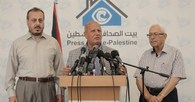
The Palestinian MP Jamal al-Khudari called Wednesday on Egypt and Norway, as the sponsor of the donors' conference, to put pressure on the Israeli occupation authority to allow construction materials’ access to Gaza.
In a press conference held in Gaza City, al-Khudari said that Gaza Strip is still suffering from the effects of the Israeli war that ended two years ago.
65,000 persons are still homeless using uninhabitable mobile homes or living in rented houses, he pointed out.
According to his statement, the IOA continued restrictions on construction materials’ entry into the Strip would make its reconstruction an impossible mission.
Only 3,000 houses out of 12,000 totally destroyed houses were rebuilt since Israel’s 2014 aggression, while 950 totally destroyed factories are still in need of reconstruction, he continued.
On the other hand, al-Khudari considered Israel’s approval to boost energy and water supplies to Gaza including by building a gas pipeline in coordination with Holland as propaganda messages.
He renewed calls for ending the Gaza siege and for opening all border crossings without any prior conditions.
In a press conference held in Gaza City, al-Khudari said that Gaza Strip is still suffering from the effects of the Israeli war that ended two years ago.
65,000 persons are still homeless using uninhabitable mobile homes or living in rented houses, he pointed out.
According to his statement, the IOA continued restrictions on construction materials’ entry into the Strip would make its reconstruction an impossible mission.
Only 3,000 houses out of 12,000 totally destroyed houses were rebuilt since Israel’s 2014 aggression, while 950 totally destroyed factories are still in need of reconstruction, he continued.
On the other hand, al-Khudari considered Israel’s approval to boost energy and water supplies to Gaza including by building a gas pipeline in coordination with Holland as propaganda messages.
He renewed calls for ending the Gaza siege and for opening all border crossings without any prior conditions.
5 sept 2016
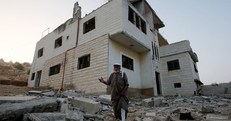
A Palestinian citizen from al-Khalil city has been prevented for about three days by the Israeli army and Jewish settlers from completing the construction of a roof for his house, according to Quds Press.
Aref Jaber, whose house is located near the Ibrahimi Mosque, said that settlers from Kiryat Arba settlement attacked him along with hired builders and prevented them from finishing the concrete roof, which was in final stages.
Jaber added that Israeli soldiers protected the settlers during their assault, noting that the Israeli army ordered him to close the house and barred any Palestinian or activist from entering the area to support him.
He also said that his sons were already arrested several times on allegations of their presence on the rooftop of the house. As a result of Israeli movement restrictions, the homeowner had to use donkeys and primitive means to transport construction materials to the area.
His failure to build the roof also caused him financial losses estimated at nearly 17,000 US dollars. He will also incur other costs to remove the parts that he built.
The Palestinian Authorities in the West Bank, in turn, have not provided the house owner with any help and left him alone in the face of Kiryat Arba settlers and their army.
Aref Jaber, whose house is located near the Ibrahimi Mosque, said that settlers from Kiryat Arba settlement attacked him along with hired builders and prevented them from finishing the concrete roof, which was in final stages.
Jaber added that Israeli soldiers protected the settlers during their assault, noting that the Israeli army ordered him to close the house and barred any Palestinian or activist from entering the area to support him.
He also said that his sons were already arrested several times on allegations of their presence on the rooftop of the house. As a result of Israeli movement restrictions, the homeowner had to use donkeys and primitive means to transport construction materials to the area.
His failure to build the roof also caused him financial losses estimated at nearly 17,000 US dollars. He will also incur other costs to remove the parts that he built.
The Palestinian Authorities in the West Bank, in turn, have not provided the house owner with any help and left him alone in the face of Kiryat Arba settlers and their army.
3 sept 2016
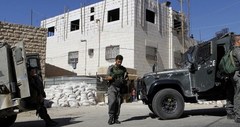
The Israeli Occupation Forces (IOF) prevented Friday a Palestinian citizen from completing the construction of his home in the Old Town of al-Khalil to the south of the West Bank.
"Israeli forces violently stormed the area and attacked my family without any reason," Aref Jaber, the home’s owner, said.
"They forced us to leave amid heavy firing of teargas bombs," he added. During the raid, an Israeli officer informed Jaber that his house is located near a closed military zone.
Jaber launched a cry for help especially in light of his very difficult living conditions as his family became homeless.
Meanwhile, Israeli municipal crews in occupied Jerusalem stormed Bassatin neighborhood in Silwan town to the south of al-Aqsa Mosque and filmed all local houses and commercial shops before handing over demolition orders against a number of them.
The demolition notifications were issued under the pretext that the Palestinian facilities were built without permit, a local activist said.
Israeli authorities have previously threatened to demolish the whole neighborhood in 2004 as a prelude to establish a Talmudic garden for Israeli settlers. The neighborhood which includes more than 100 homes inhabited by 1,600 people is subjected to weekly provocative raids.
"Israeli forces violently stormed the area and attacked my family without any reason," Aref Jaber, the home’s owner, said.
"They forced us to leave amid heavy firing of teargas bombs," he added. During the raid, an Israeli officer informed Jaber that his house is located near a closed military zone.
Jaber launched a cry for help especially in light of his very difficult living conditions as his family became homeless.
Meanwhile, Israeli municipal crews in occupied Jerusalem stormed Bassatin neighborhood in Silwan town to the south of al-Aqsa Mosque and filmed all local houses and commercial shops before handing over demolition orders against a number of them.
The demolition notifications were issued under the pretext that the Palestinian facilities were built without permit, a local activist said.
Israeli authorities have previously threatened to demolish the whole neighborhood in 2004 as a prelude to establish a Talmudic garden for Israeli settlers. The neighborhood which includes more than 100 homes inhabited by 1,600 people is subjected to weekly provocative raids.
